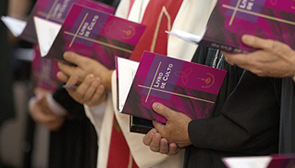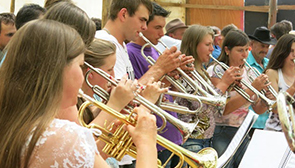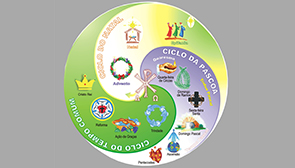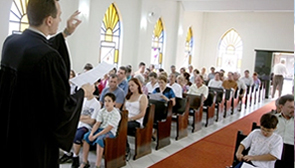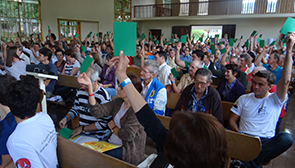THE MEISSEN AGREEMENT
TEXTS
Chairmen's Foreword
1 The immediate stimulus for this statement dates from 1983, the fifth centenary of Martin Luther's birth. In that year major public celebrations were held in Leipzig and Worms, and the Archbishop of Canterbury (Dr. Robert Runcie) chose this opportunity to propose that closer relations should be established between the Church of England and the German Evangelical Churches. This initiative met a warm response from the Council of the Evangelical Church in Germany and the Church Leaders' Conference of the Federation of the Evangelical) Churches in the German Democratic Republic.
2 Increasingly cordial relations had, in fact, been developing since 1945. The main focus for church links between England and the German Democratic Republic has been the partnership between Coventry and Dresden, though there have been numerous other contacts as well. The growing fellowship between the Evangelical Church in Germany and the Church of England — fully documented in a pamphlet by Oberkirchenrat K. Kremkau1) — has included not only local twinning links, but also official theological conversations since 1964.
3 A further impetus to developing these relationships was given by the publication of the reports of the Anglican-Lutheran European Commission (1982), the International Anglican-Lutheran Joint Working Group ( 1983), the Anglican-Reformed International Commission ( 1984) and the text Baptism, Eucharist and Ministry of the Faith and Order Commission of The World Council of Churches ( 1982).
4 The presence of Anglican congregations in the Federal Republic of Germany and of Evangelical German-speaking congregations in Great Britain is an additional factor underlining the desirability of closer links.
5. From 1985 onwards official delegates were appointed by the Church of England, the Federation of the Evangelical Churches in the German Democratic Republic and the Evangelical Church in Germany in the Federal Republic of Germany to work out a basis for closer relations. (The names of participants are shown in the appendix.) This work was begun in February 1987 at London Colney (UK), elaborated by a small working group in November 1987 at Schloss Schwanberg (FRG) and concluded in March 1988 at Meissen (GDR). The statement is unanimous, and is now offered to the appropriate authorities of each Church for endorsement. (The English and German texts are equally authentic.)
6 We would draw particular attention to the structure of our Statement. Its first five sections deliberately draw on the findings of previous ecumenical dialogues. We intend to build on valuable work already done which is still in the process of reception by our Churches. We would not wish the Declaration in Chapter VI to be viewed in isolation from the important Common Statement which precedes it.
7 If these proposals are accepted, as we keenly hope they soon will be, the future relations between our Churches will need to be undergirded by bilateral agreements and a framework of continuing co-operation. This Statement will be supplemented in due course by detailed practical suggestions, now being worked out by the ecumenical officers of our Churches.
+ David Grimsby Dr. Johannes Hempel DD D. Karlheinz Stoll
On the Way to Visible Unity
A Common Statement
18 March,1988, Meissen
1 The Church as sign,
instrument and foretaste of the Kingdom of God
1 God's plan as declared in the Holy Scriptures is to reconcile all things in Christ in, through and for whom they were made.
2 For this purpose, God chose Israel, sent Jesus Christ and commissioned the Church. Abraham's call was for the blessing of all peoples (Gen.12:1-3). The servant of God will not only restore the scattered people of lsrael; he is given ‘as a light to the nations’, to bring salvation to the end of the earth (Is. 49:6). In Christ God was reconciling the whole world to himself (II Cor. 5:19; Col.1:15-20). The Letter to the Ephesians recognises the implications of the work of Christ for the mystery, the call and the mission of the Church, when it says God has blessed us in Christ with every spiritual blessing. . . He has made known to us in all wisdom and insight the mystery of his will, according to his purpose which he set forth in Christ as a plan for the fullness of time, to unite all things in him, things in heaven and things on earth (Eph.1:3, 9,10). ‘But grace was given to each of us according to the measure of Christ's gift. . . And his gifts were that some should be apostles, some prophets, some evangelists, some pastors and teachers, to equip the saints for the work of ministry, for building up the body of Christ until we all attain to the unity of the faith and of the knowledge of the Son of God, to mature manhood, to the measure of the stature of the fullness of Christ’(Eph.4:7,11-13).
3 The Church, the body of Christ, must always be seen in this perspective as instrumental to God's ultimate purpose. The Church exists for the glory of God and to serve, in obedience to the mission of Christ, the reconciliation of humankind and of all creation. Therefore the Church is sent into the world as a sign, instrument and foretaste of a reality which comes from beyond history - the Kingdom, or Reign of God. It is already a provisional embodiment of God's will which is the coming of the Kingdom2). The Church is a divine reality, holy and transcending present finite reality. At the same time, as a human institution, it shares all the ambiguity and frailty of the human condition and is always in need of repentance, reform and renewal3).
II The Church as koinonia
4 Today we are re-discovering, together with other Christians, the communal character of the Church. Underlying many of the New Testament descriptions of the Church, such as the people of God, the body of Christ, the bride, the temple of the Spirit, is the reality of a koinonia — a communion — which is a sharing in the life of the Holy Trinity and therein with our fellow-members of the Church. This community — koinonia — according to the Scriptures is established by a baptism inseparable from faith and conversion. The vocation of all the baptised is to live as a corporate priesthood offering praise to God, sharing the good news and engaging in mission and service to humankind. This common life is sustained and nurtured by God's grace through word and sacrament. It is served by the ordained ministry and also held together by other bonds of communion (see para. 8).
5 The Church is the community (koinonia) of those reconciled with God and with one another. It is the community of those who, in the power of the Holy Spirit, believe in Jesus Christ and are justified through God's grace. It is also the reconciling community because it has been called to bring to all humankind God's gracious offer of redemption and renewal4). Because the koinonia is also a participation in Christ crucified, it is also part of the nature and mission of the Church to share in the sufferings and struggles of humankind, in a world alienated from God and divided within itself by our disobedience to his will.
III Growth towards full, visible unity
6 In order to fulfil its mission the Church itself must be united. It is within a missionary perspective that we can begin to overcome the divisions which have kept us apart. As our Churches grow in faith into the fullness of Christ, so they will themselves grow together in unity. This unity will reflect the different gifts God has given to his Church in many nations, languages, cultures and traditions. The unity we seek must at one and the same time respect these different gifts and manifest more fully the visibility of the one Church of Jesus Christ.
7 Perfect unity must await the final coming of God's Kingdom, where all will be completely obedient to God and therefore totally reconciled to one another in God. But in a fallen world we are committed to strive for the full, visible unity’ of the body of Christ on earth. We are to work for the manifestation of unity at every level, a unity which is grounded in the life of the Holy Trinity and is God's purpose for the whole of creation. All our attempts to describe this vision are bound to be provisional. We are continually being led to see fresh depths and riches of that unity and to grasp new ways in which it might be manifested in word and life. Every experience of unity is a gift of God and a foretaste and sign of the Kingdom.
8 As the Churches grow together the understanding of the characteristics of full, visible unity become clearer. We can already claim together that full, visible unity must include:
— a common confession of the apostolic faith in word and life. That one faith has to be confessed together, locally and universally, so that God's reconciling purpose is everywhere shown forth. Living this apostolic faith together the Church helps the world to attain its proper destiny.
— the sharing of one baptism, the celebrating of one eucharist and the service of a reconciled, common ministry. This common participation in one baptism, one eucharist and one ministry unites ‘all in each place with ‘all in every place’ within the whole communion of saints. The wholc Church is present in every celebration of the eucharist, thus uniting the local and the universal Church. Through the visible communion the healing and uniting power of the Triune God is made evident amidst the divisions of humankind.
— bonds of communion which enable the Church at every level to guard and interpret the apostolic faith, to take decisions, to teach authoritatively, to share goods and to bear effective witness in the world. The bonds of communion will possess personal, collegial and communal aspects. At every level they are outward and visible signs of the communion between persons who, through their baptism and eucharistic fellowship, are drawn into the fellowship of the Triune God.
IV Communion already shared
9 As God makes this unity more visible we recognise that we already share a real communion. This includes the common gift of the Holy Scriptures as the authentic record of God's revelation in Jesus Christ and as the norm for Christian faith and life; the decisions of the early Ecumenical Councils; the Apostles' Creed and the Niceno-Constantinopolitan Creed as the Church's authoritative interpretation of the apostolic faith; a common pre-Reformation western tradition of worship, spirituality and theology; a Reformation inheritance expressed in the Thirty-Nine Articles of Religion, the Book of Common Prayer and the Ordinal, and in the Augsburg Confession and the Heidelberg Catechism; a similar historical tradition of worship, centred on the proclamation and celebration of the living Christ in word and sacrament and now converging with other Christian traditions within the liturgical renewal.
10 Although we became estranged and have lived in separation, we have never condemned each other as Churches. In the l9th century our churches engaged in a number of joint missionary endeavours. In the dark years between 1933 and 1945 some members of our Churches came together in a true communion of witness. This relationship developed after the Second World War and has continued to bear fruit in the wider Ecumenical Movement.
11 Now we rejoice that we are growing together. There has been co-operation in many areas of social and pastoral concern, we have shared in theological dialogue, our fellowship has been fostered by exchanges, by twinnings of local congregations, and by visits at every level. We are already able to invite each other to receive Holy Communion in our churches.
12 We acknowledge in our Churches in their separation an existing fidelity to the apostolic faith and mission, to the celebration of baptism and eucharist, and to the exercise of ordained ministries as given by God and instruments of his grace.
13 Our growing together is part of a wider movements towards unity within the one Ecumenical Movement. Of particular relevance to our present agreement are the following agreements and closer relations:
(i) In the 1920s and 1930s the Church of England established intercommunion with the Lutheran Churches of Sweden and Finland, Latvia and Estonia. This involved mutual eucharistic hospitality and permission to preach and assist at the eucharist. Bishops of the Church of England and of the Churches of Sweden and Finland have taken part in one another's episcopal consecrations from time to time. There has also been official mutual eucharistic hospitality between the Church of England and the Churches of Norway, Denmark and Iceland since the 1950's. In the United States of America Lutheran and Episcopal churches moved in 1986 into ‘interim eucharistic fellowship’.
(ii) Similarly, Anglicans and Reformed are involved in a number of national unity negotiations in various parts of the world. These already involve varying degrees of eucharistic fellowship in the USA and in Wales. The two traditions have come together in the United Churches in the Indian Subcontinent. In England, Anglicans and Reformed, and indeed (in one case) Lutherans, live together in local ecumenical projects where they share life, worship and ministry. In some places this includes the sharing of oversight ‘above’ the local level.
(iii) The Church of England, the Evangelical Church in Germany and the Federation of the Evangelical Churches in the German Democratic Republic have close relations with the Old Catholics. The Church of England established intercommunion with the churches of the Union of Utrecht through the Bonn Agreement of 193I. The member churches of the Evangelical Church in Germany and of the Federation of the Evangelical Churches in the German Democratic Repuhlic and the Old Catholic Church in the Federal Republic of Germany and in the German Democratic Republic offer each other eucharistic hospitality.
(iv) Lutheran, Reformed and United Churches in the Federal Republic of Germany, in the German Democratic Republic and in the United Kingdom adhere to the Leuenberg Agreement between Reformation Churches in Europe, which declares ‘pulpit and altar fellowship ‘. In 1987 the Evangelical Methodist Church in the Federal Republic of Germany and the member churches of the Evangelical Church in Germany also entered into ‘pulpit and altar fellowship’. Similar proposals are at present before the churches in the German Democratic Republic.
V Agreement in faith
14 The recommendations which we make in para.17 are grounded in the agreed statements between representatives of the Churches of the Anglican Communion and the Lutheran World Federation, and the Churches of the Anglican Communion and the World Alliance of Reformed Churches; and — at the European level — between representatives of Anglican and Lutheran Churches in Europe5). Alongside these agreed statements must also be set the report of the Faith and Order Commission of the WCC Baptism, Eucharist and Ministry6) and the reports of Anglican, Lutheran and Reformed dialogues with the Roman Catholic Church. All these agreed texts are still in the process of adoption and reception by our Churches. They all display a remarkable theological consistency which already indicates a substantial convergence between the Churches.
15 As a result of these dialogues the Church of England, the Federation of the Evangelical Churches in the German Democratic Republic with its member churches and the Evangelical Church in Germany in the Federal Republic of Germany with its member Churches are now able to record the following points of agreement:
(i) We accept the authority of the canonical Scriptures of the Old and New Testaments. We read the Scriptures liturgically in the course of the Church's year7).
(ii) We accept the Niceno-Constantinopolitan and Apostles' Creeds and confess the basic trinitarian and christological dogmas to which these creeds testify. That is, we believe that Jesus of Nazareth is true God and true Man, and that God is one God in three persons, Father, Son and Holy Spirit8).
(iii) We celebrate the apostolic faith in liturgical worship. We acknowledge in the liturgy both a celebration of salvation through Christ and a significant factor in forming the consensus fidelivm. We rejoice at the extent of ‘our common tradition of spirituality, liturgy and sacramental life ‘ which has given us similar forms of worship, common texts, hymns, canticles and prayers. We are influenced by a common liturgical renewal. We also rejoice at the variety of expression shown in different cultural settings9).
(iv) We believe that baptism with water in the name of the Triune God unites the one baptised with the death and resurrection of Jesus Christ, initiates into the One Holy, Catholic and Apostolic Church, and confers the gracious gift of new life in the Spirit10.
(v) We believe that the celebration of the eucharist is the feast of the new covenant instituted by Jesus Christ in which the word of God is proclaimed and in which the risen Christ gives his body and blood under the visible signs of bread and wine to the community. ‘In the action of the eucharist Christ is truly present to share his risen life with us and to unite us with himself in his self-offering to the Father, the one full, perfect and sufficient sacrifice which he alone can offer and has offered once for all’11). In this celebration we experience the love of God and the forgiveness of sins in Jesus Christ and proclaim his death and resurrection until he comes again and brings his Kingdom to completion12).
(vi) We believe and proclaim the gospel that in Jesus Christ God loves and redeems the world. We ‘share a common understanding of God's justifying grace, i. e. that we are accounted righteous and are made righteous before God only by grace through faith because of the merits of our Lord and Saviour Jesus Christ, and not on account of our works or merits. . . Both our traditions affirm that justification leads and must lead to 'good works'; authentic faith issues in love’ 13).
(vii) We believe that the Church is constituted and sustained by the Triune God through God's saving action in word and sacraments, and is not the creation of individual believers. We believe that the Church is sent into the world as sign, instrument and foretaste of the Kingdom of God. But we also recognise that the Church stands in constant need of reform and renewal14).
.
(viii) We believe that all members of the Church are called to participate in its apostolic mission. They are therefore given various ministries by the Holy Spirit. Within the community of the Church the ordained ministry exists to serve the ministry of the whole people of God. We hold the ordained ministry of word and sacrament to be a gift of God to his Church and therefore an office of divine institution15).
(ix) We believe that a ministry of pastoral oversight (episkope), exercised in personal, collegial and communal ways, is necessary to witness to and safeguard the unity and apostolicity of the Church16).
(x) We share a common hope in the final consummation of the Kingdom of God, and believe that in this eschatological perspective we are called to work now for the furtherance of justice and peace. The obligations of the Kingdom are to govern our life in the Church and our concern for the world. ‘The Christian faith is that God has made peace through Jesus by the blood of his cross' (Col 1:20) so establishing the one valid centre for the unity of the whole human family’17).
16 Lutheran, Reformed and United Churches, though being increasingly prepared to appreciate episcopal succession as a sign of the apostolicity of the life of the whole Church, hold that this particular form of episkope should not become a necessary condition for ‘full, visible unity’ . The Anglican understanding of full, visible unity includes the historic episcopate and full interchangeability of ministers. Because of this remaining difference our mutual recognition of one another's ministries does not yet result in the full interchangeability of ministers. ‘Yet even this remaining difference, when seen in the light of our agreements and convergences, cannot be regarded as a hindrance to closer fellowship between our Churches’18).
VI Mutual acknowledgement and next steps
17 We recommend that our Churches jointly make the following Declaration:
‘We the Church of England, the Federation of the Evangelical Churches in the German Democratic Republic with its member churches and the Evangelical Church in Germany with its member churches, on the basis of our sharing the common apostolic faith and in the light of what we have re-discovered of our common history and heritage, expressed in chapters I - V, commit ourselves to strive together for full, visible unity.’
A (i) We acknowledge one another's churches as churches belonging to the One, Holy, Catholic and Apostolic Church of Jesus Christ and truly participating in the apostolic mission of the whole people of God;
(ii) we acknowledge that in our churches the Word of God is authentically preached and the sacraments of baptism and eucharist are duly administered;
(iii) we acknowledge one another's ordained ministries as given by God and instruments of his grace, and look forward to the time when the reconciliation of our churches makes possible the full interchangeability of ministers;
(iv) we acknowledge that personal and collegial oversight (episkope) is embodied and exercised in our churches in a variety of forms, episcopal and non-episcopal, as a visible sign of the Church's unity and continuity in apostolic life, mission and ministry.
B We commit ourselves to share a common life and mission. We will take all possible steps to closer fellowship in as many areas of Christian life and witness as possible, so that all our members together may advance on the way to full, visible unity.
As the next steps we agree:
(i) to continue official theological conversations between our churches, to encourage the reception of the theological consensus and convergence already achieved and to work to resolve the outstanding differences between us;*
(ii) to establish forms of joint oversight so that our churches may regularly consult one another on significant matters of faith and order, life and work;*
(iii) to participate in one another's worship, including baptism, eucharist and ordinations;
(iv) that authorised ministers of our churches may, subject to the regulations of the churches and within the limits of their competence, carry out the tasks of their own office in congregations of the other churches when requested;
If these functions are to be exercised for an extended period of service rather than on a single occasion, an invitation from the appropriate authority is necessary for the carrying out of these tasks.
(v) that the Church of England invites members of the member churches of the Federation of the Evangelical Churches in the German Democratic Republic and the member churches of the Evangelical Church in Germany to receive Holy Communion according to the order of the Church of England; the member churches of the Federation of the Evangelical Churches in the German Democratic Republic and the member churches of the Evangelical Church in Germany invite members of the Church of England to receive Holy Communion according to their respective orders. We encourage the members of our churches to accept the eucharistic hospitality extended to them and thus express their unity with one another in the One Body of Christ;
(vi) that whenever in our churches the people of God assemble for eucharistic worship, the ordained ministers of our churches, in accordance with their rules, may share in the celebration of the eucharist in a way which advances beyond mutual eucharistic hospitality but which falls short of the full interchangeability of ministers** Such eucharistic fellowship will reflect the presence of two or more churches expressing their unity in faith and baptism, and demonstrate that we are still striving towards making more visible the unity of the One, Holy, Catholic and Apostolic Church and that we are strengthening and encouraging one another on the way to that goal in this eucharistic fellowship with the One Lord Jesus Christ;
Such services of the eucharist are presided over by an ordained minister. Only this person may say the eucharistic prayer.
In the eucharistic prayer the narrative ot the institution is bound up with thanksgiving to the Father, the remembrance ot the salvific work of Christ (Anamnesis) and the invocation of the Holy Spirit (Epiklesis).
In such services the rite used should be one authorised by the church of the presiding minister.
The liturgical arrangements, including the allotting of the different parts of the service, should be determined according to local circumstances and traditions.
An appropriate procedure for the elements remaining after the celebration must be followed. ‘Each church should respect the practices and piety of the others. the best way of showing respect for the elements served in the eucharistic celebration is by their consumption, without excluding their use for communion of the sick19).
Ministers should be vested in the manner appropriate to their tradition.
(vii) that whenever a bishop or minister accepts an invitation to take part in an ordination of another church this expresses the commitment of our churches to the unity and apostolicity of the Church. Until we have a reconciled, common ministry such participation in ordination cannot involve acts which by word or gesture might imply that this has already been achieved.
For the Church of England this means that a participating bishop or priest may not by the laying on of hands or otherwise do any act which is a sign of the conferring of Holy Orders. He may take part in a separate laying on ot hands as an act of blessing.
18 The above Declaration will come into force when it is accepted by the Church of England, the Federation of the Evangelical Churches in the German Democratic Republic and the Evangelical Church in Germany according to their internal rules and practices. We recommend that our churches express in worship their commitment to share a common life and mission and to strive for full, visible unity.
19 The implementation of the proposals in this Declaration will mark an important stage in the growth towards full, visible unity of the Church. We know that beyond this commitment lies a move from recognition to the reconciliation of churches and ministries within the wider fellowship of the universal Church.



